Although all types of falcons are birds of prey, each species is quite distinct.
Falcons are uniquely adapted to life as apex predators and are known for their stealthy hunting and incredible speed.
Since these majestic birds of prey live and hunt silently, it may seem impossible to distinguish different types of falcons from each other.
This field guide will help you know what clues to look for to be able to quickly identify some key species.
We will begin our journey of discovery into the lives of falcons with some general information and follow that up with a closer look at a few falcon types.

What Is A Falcon?
Falcons are highly specialized carnivores that actively hunt for prey which include reptiles, rodents, insects, smaller birds, and small vertebrates.
They are the largest genus in the family Falconidae, and their genus is called Falco.
Falcons differ from other raptors like hawks and eagles as they have a specialized beak equipped with a tomial tooth specifically used to kill prey. Eagles and hawks usually kill using their strong feet before ripping prey apart.
Also, they have thin, tapered wings that allow these types of birds to fly and quickly maneuver at high speed.
The group of birds referred to as falcons live solitary lifestyles. They are diurnal birds which means that they hunt during the day.
In the wild, they have lifespans of 12 – 20 years, and some captive birds have reached 25 years of age.
A notable feature of falcons is that they take the honor of being the fastest creatures on Earth. Peregrine falcons have been recorded reaching a top speed of 242 miles an hour!
Falcon Types
There are at least 40 species of falcons. The largest is the gyrfalcon which can be 25 inches long, and the smallest is the pygmy falcon which only reaches a maximum length of 7.8 inches.
Various types of falcons live on every continent on Earth except Antarctica.
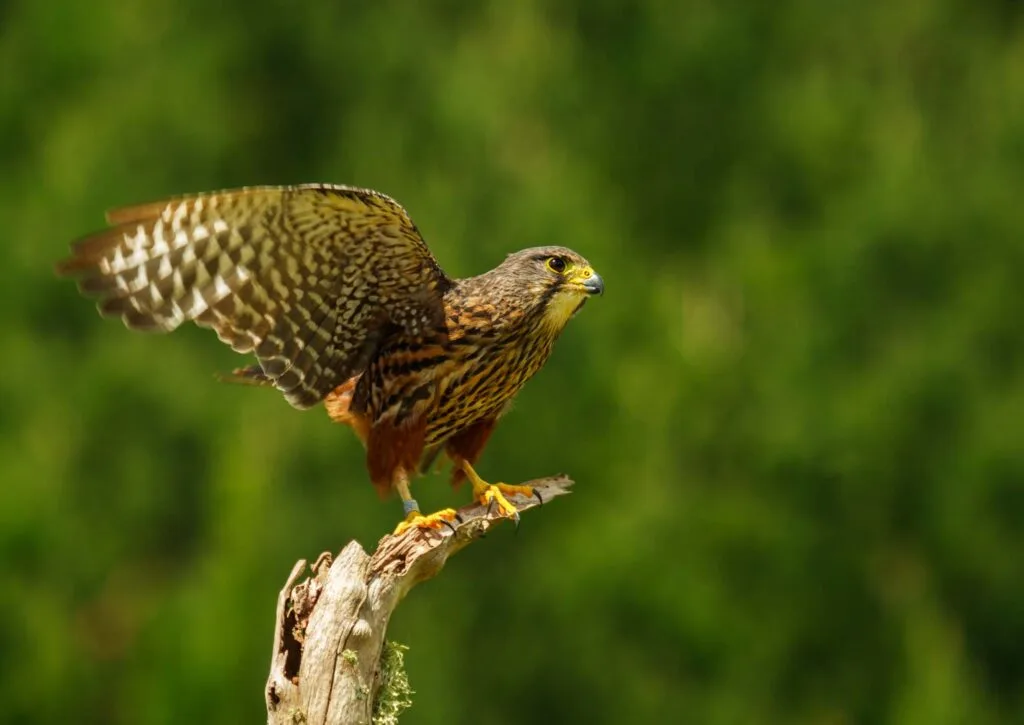
Different types of falcons are divided into four groups which have distinct characteristics. These are the following:
Kestrels
Except for the American kestrel, the rest of the group is small with a sturdy build. There are fifteen species in this group, and their preferred diet is vertebrates and invertebrates – the type depends on the size of the species.
Hobbies
This group is characterized by their dark gray plumage, and they are often slightly smaller than other types of falcons with long, narrow wings. A large part of their diet consists of smaller birds. There are nine species within this group.
Falcons
These are the fastest birds of the family and include peregrine falcons. True falcons are powerfully built and often have dark faces and caps. These birds dine predominantly on smaller birds and terrestrial vertebrates.
Hierofalcons
These are four falcon types that are very closely related. The four, lanner falcons, laggar falcons, saker falcons, and gyrfalcons, all look similar to peregrine falcons, but their patterning may resemble that of hawks.
19 Different Types of Falcons
Let’s learn more about the intriguing lives of some particular types of falcons.
1. Peregrine Falcon (Falco peregrinus)
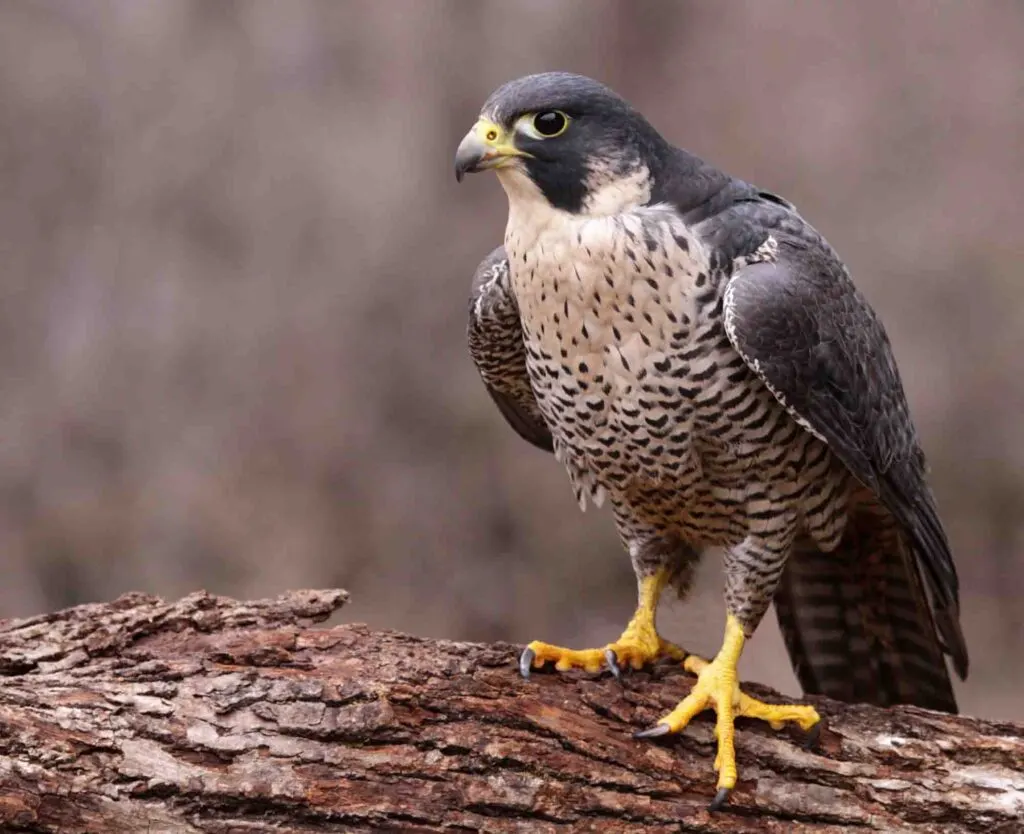
Peregrines are the fastest types of falcons, and of any type of bird, to be honest.
These expert migrators use the technique called ‘the stoop’ when they dive at their prey.
Their speed can reach 240 miles per hour at this point, making them not only one of the fastest birds but also the fastest animals on the planet. (Yes, even faster than the cheetah!)
Females are about 30% larger than males, reaching up to 23 inches in body length and 47 inches in wingspan. Also, the females weigh up to 3.3 lbs, while the males weigh 2.2 lbs.
Peregrine falcons feed almost exclusively on medium-sized birds such as pigeons, waterfowls, phasianids, songbirds, and waders.
These types of falcons are distributed across the globe, from North America to Oceania.
Their preferred habitats are river valleys, mountain ranges, coastlines, and increasingly cities, where these true falcons nest on tall places like buildings, towers, and bridges.
2. Gyrfalcon (Falco rusticolus)
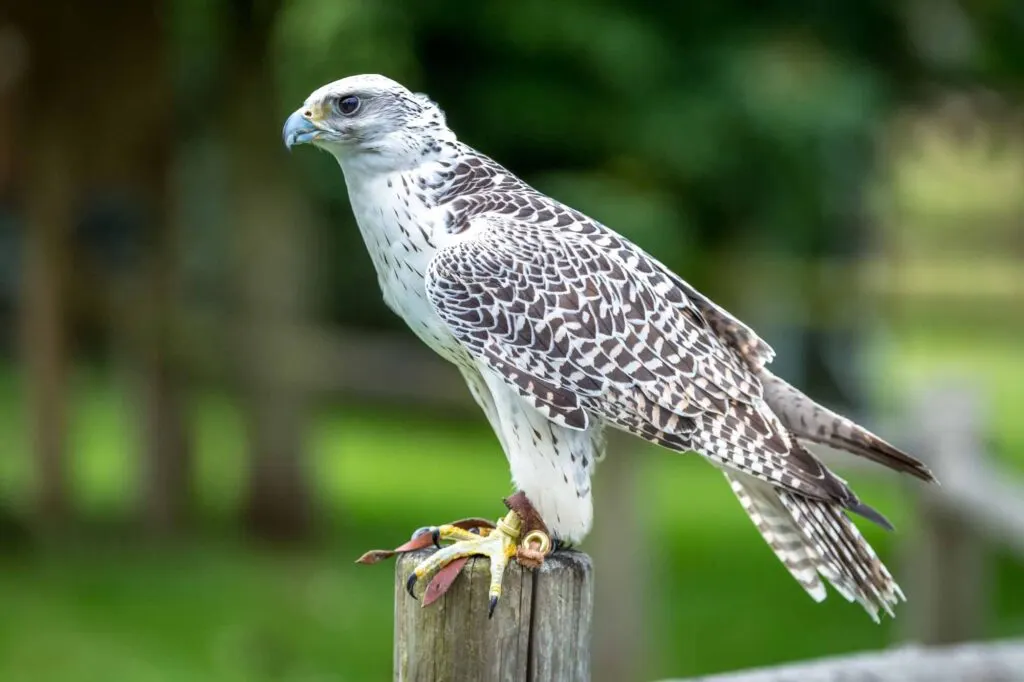
We have already mentioned that the gyrfalcon is the largest falcon in the family. This unique bird species has been highly prized in falconry since ancient times.
Although gyrfalcons have been transported worldwide as sports birds, they occur naturally in the cold Arctic tundra regions. They only come south as far as the northern parts of Canada during winter.
Gyrfalcons have a peculiar trait when it comes to color, and birds can vary considerably in different regions.
Colors can range from stunning white to dark brown or gray with black markings on the chest. These color variations are known as morphs.
Female gyrfalcons are considerably longer and heavier than males and can be almost three times larger. While the average weight of an adult male gyrfalcon is less than 3 lbs, females average up to 4 lbs.
This impressive falcon feeds mainly on other birds. Its preferred choice is ptarmigan, but it is opportunistic and will take anything from gulls to owls and songbirds.
Gyrfalcons also hunt land mammals and are able to prey on animals as large as hares.
3. Pygmy Falcon (Polihierax semitorquatus)
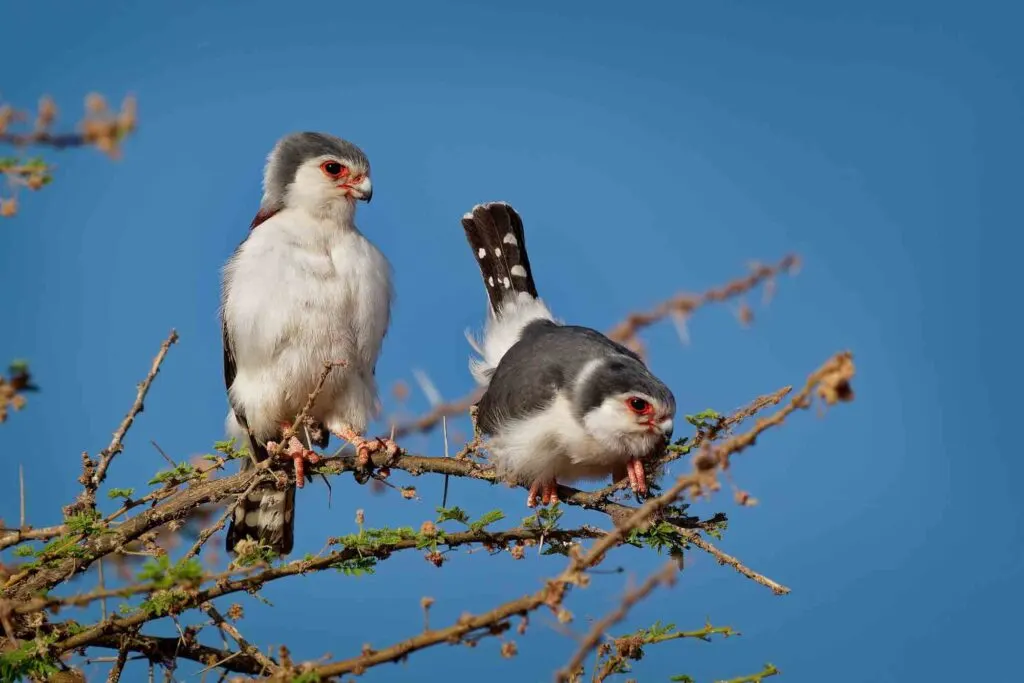
Moving over to the African savanna, you will find the smallest member of the falcon family.
Pygmy falcons are also called African pygmy falcons, and their scientific name is a tongue twister – Polihierax semitorquatus.
The tiny gray and white pygmy falcon may be petite, but they are no less fierce than their larger relatives.
Pygmy falcons live in dry bushland areas and are dependent on weaver nests to breed.
Instead of putting any effort into building nests, these small falcons take over a section of a multichambered weaver compound and raise their young.
It is a peculiar setup as pygmy falcons also prey on smaller birds, but they coexist while nesting.
Pygmy falcons of both sexes weigh between 1.5 – 2.5 ounces. The only difference between the sexes is that males have more gray feathers over their backs, while females are a chestnut color.
Since they live in scrubby bushland areas, the diet of pygmy falcons fits with small prey animals around them.
This includes skinks, small snakes, beetles, lizards, and rodents. Occasionally they may also snack on a weaver that they board with, but that is rare.
4. American Kestrel (Falco sparverius)
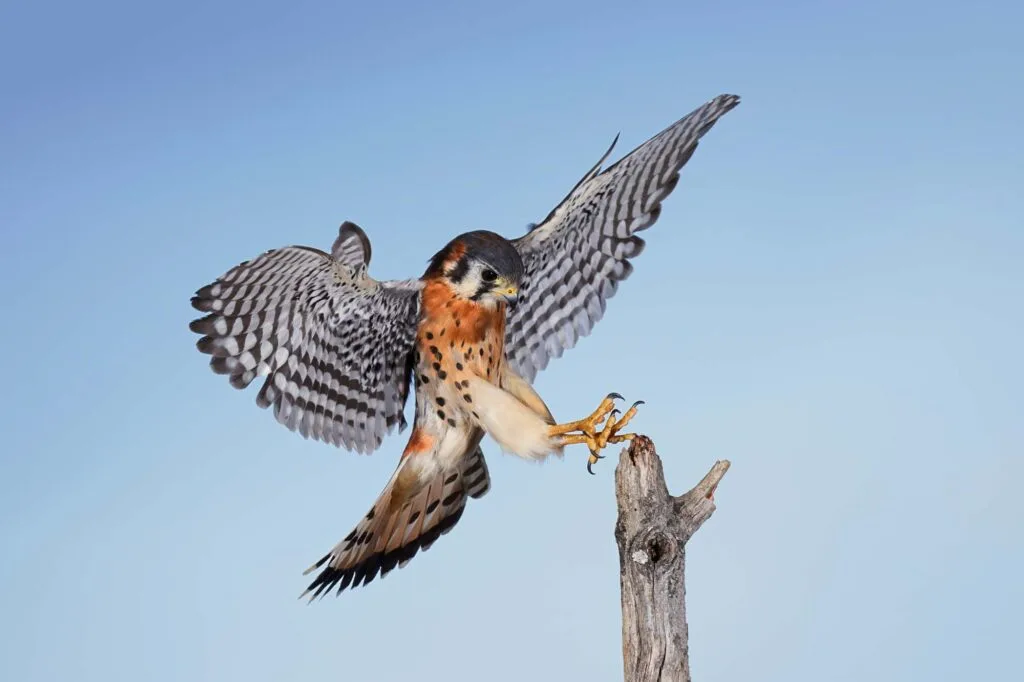
The common name for the American kestrel is sparrow hawk. Its scientific name is Falco sparverius.
These birds of prey are common in North America, including as far as the northern parts of Canada in the summer, Central America, but also South America.
Since the range of the American kestrel is so extensive, there is a regional variation in size and weight between birds.
In addition, seventeen subspecies are recognized, each with distinctive plumage, calls, and size.
With regards to the size and weight of sparrow hawks, it is safe to say that female American kestrels are always larger than males and weigh between 3 and 5.8 ounces.
In terms of plumage color, both sexes can have the same coloration, which usually includes rusty color barring over the back.
Although these small falcons can hunt from the air, they typically prefer to scan the surroundings while perched on fence posts and ambush prey.
Since they are small predatory birds, prey includes insects, mice, lizards, and small birds, including sparrows.
5. Prairie Falcon (Falco mexicanus)
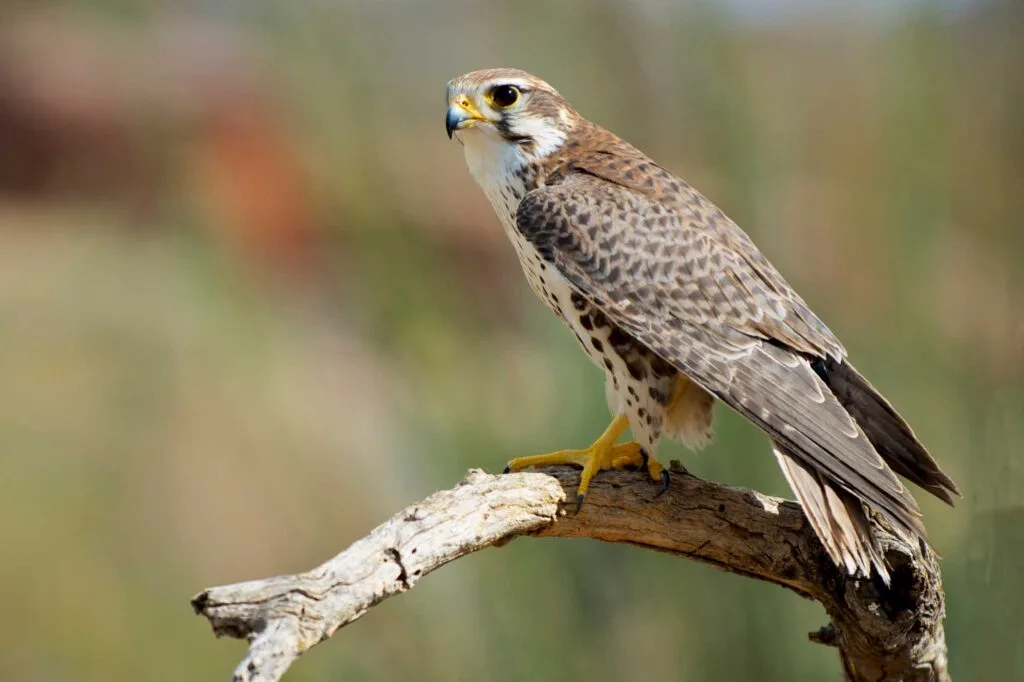
Falco mexicanus, more commonly known as the prairie falcon, is the only large falcon type exclusively native to North America.
These impressively sized birds mainly inhabit harsh arid regions in the western United States, including southern Canada and northern Mexico.
Like all types of falcons, females are bigger than males. In appearance, they are about the same size as a crow.
Although prairie falcons may look big compared to many other falcon types and have a wingspan of around 40 inches, their bodies below their feathers are quite small, and their average weight is only about 1.6 lbs.
In appearance, the prairie falcon is similar to peregrine falcons. They are a pale, warm gray with dark mottling and a characteristic mustache.
When they are in flight, it is easy to distinguish these species apart as prairie falcons have characteristic dark wing pits that create the effect of struts along the underside of their body.
Prairie falcons are adapted to live in scrubby, dry open areas. They nest on cliffs but may travel considerable distances to hunt.
They feed mainly on small mammals like ground squirrels, prairie dogs, reptiles, and birds they can catch in flight.
6. Orange-Breasted Falcon (Falco deiroleucus)
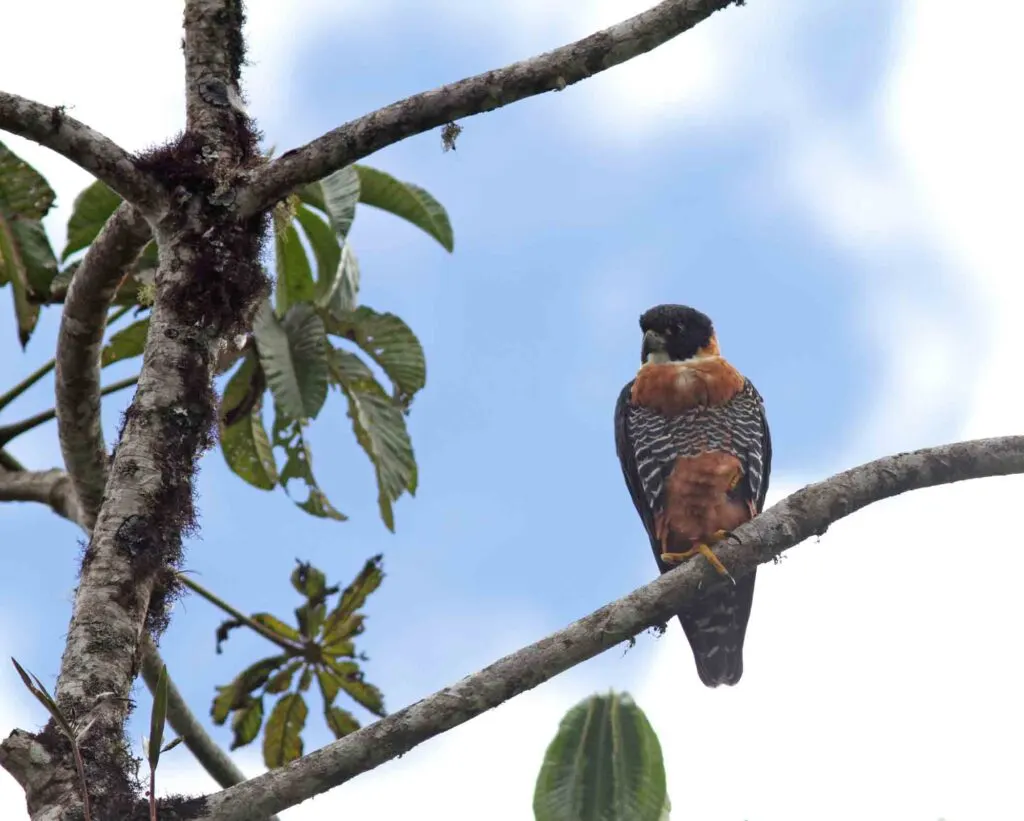
Not all types of falcons are abundant, and the orange-breasted falcon is an example of a rare species.
Causes for their decreasing numbers include habitat loss, Africanized bees, and black vultures that negatively impact the nesting success of this falcon species. It is classified as near threatened by the IUCN.
Orange-breasted falcons are attractive birds that are very similar in appearance to bat falcons.
They inhabit open areas within mature forests from the south of Mexico in North America, but also in Central and South America. Their scientific name is Falco deiroleucus.
Females are significantly larger than males. While the average weight of male orange-breasted falcons is between 11 – 15 ounces, females weigh between 19 and 25 ounces. Both sexes have similar plumage.
The most striking feature is the rusty orange color bands that extend from the upper breast up and around the top section of the neck and lower belly.
Over the front area of the underside, the orange-breasted falcon appears to be wearing a dark waistcoat featuring white tips and bars.
These compact-looking falcons feed exclusively on flying prey. It uses a stealth technique of suddenly diving down from a high position to grab unsuspecting prey in midair.
This includes an assortment of birds and bats.
7. Common Kestrel (Falco tinnunculus)
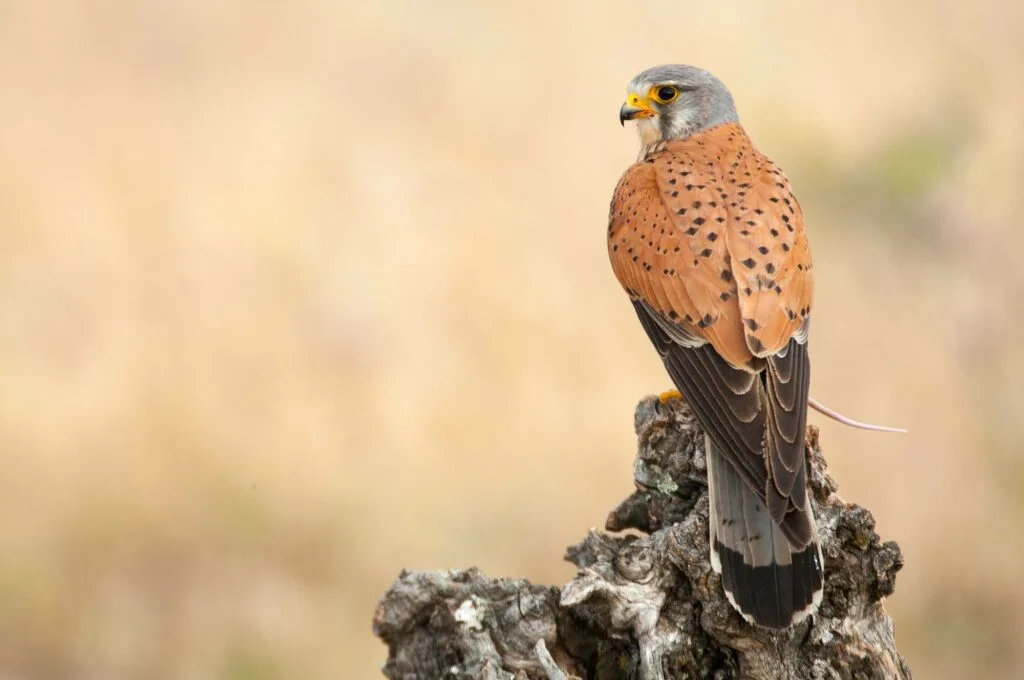
Unlike the American kestrel, the common kestrel is a European bird that is widespread in Europe, Asia, and Africa. It is the only species of kestrel that occurs in the United Kingdom.
Common kestrels, Falco tinnunculus, are also known as European kestrels, Old World kestrels, or simply kestrels throughout their range.
This type of falcon is highly adaptable and will readily nest in natural or artificial structures like buildings or raised nesting perches.
The average weight of female common kestrels is 6.5 ounces, and males are an ounce lighter.
Besides the size difference, sexes are easy to tell apart. The most striking difference is that adult males have a gray head and tail and feature fewer spots over their backs.
Females are a more uniform brown, with plenty of dark spots and streaks.
Almost three-quarters of a common kestrel’s diet comprises small mammals like voles, shrews, and mice.
In places or at times when their usual prey is short, they will take smaller birds and occasionally frogs and bats.
Their most common method of hunting involves hovering in the air while surveying the ground using their extraordinary vision.
Did you know? The tail color of the common and lesser kestrels is absolutely identical, yet they do not seem closely related.
8. Aplomado Falcon (Falco femoralis)
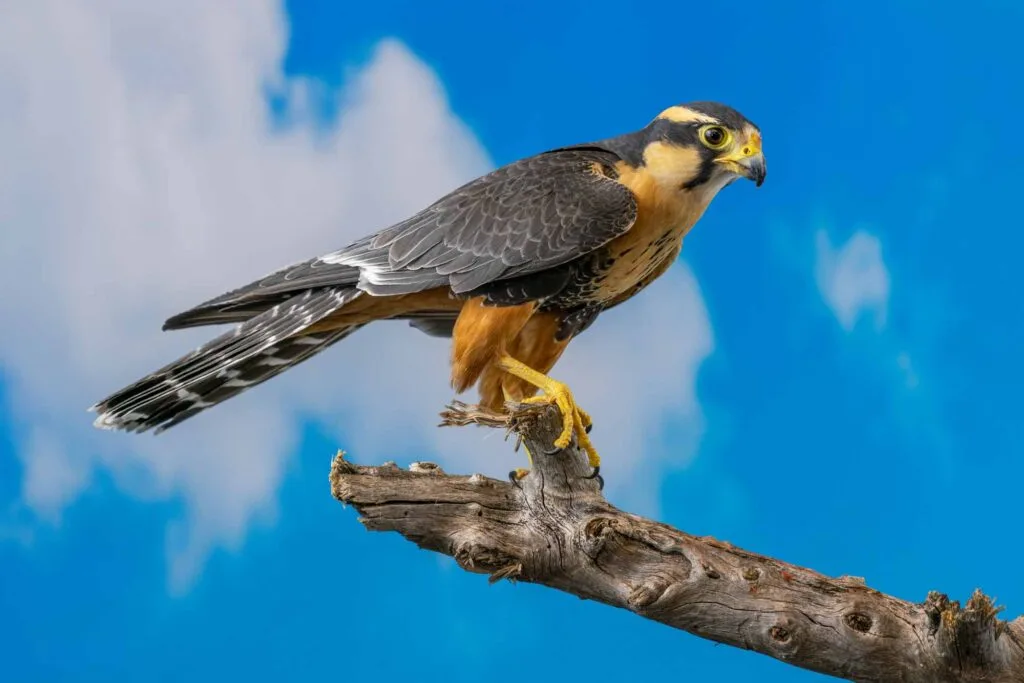
Aplomado falcons are highly prized in the sport of falconry and are known for their long wings and tails.
These falcons are abundant in the central and southern regions of South America. Efforts are being made to reintroduce them to parts of Texas.
The scientific name for the aplomado falcon is Falco femoralis. Both sexes have similar coloration and patterning, but females are larger than males.
These falcons have long slender bodies, and average weights are between 7.3 and 10.8 ounces in males and 9.6 and 16 ounces in females.
Unlike many other types of falcons that live solitary lives, aplomado falcons have been recorded hunting cooperatively in pairs.
Smaller birds make up most of their prey, although female aplomado falcons have been known to take prey even bigger than themselves.
Although these birds are prized in falconry, their numbers are stable as most birds used for the sport are bred in captivity.
Aplomado falcons nest in bushes or trees, and nest platforms are being used successfully in areas in the southern United States where reintroduction efforts are taking place.
9. Merlin (Falco columbarius)
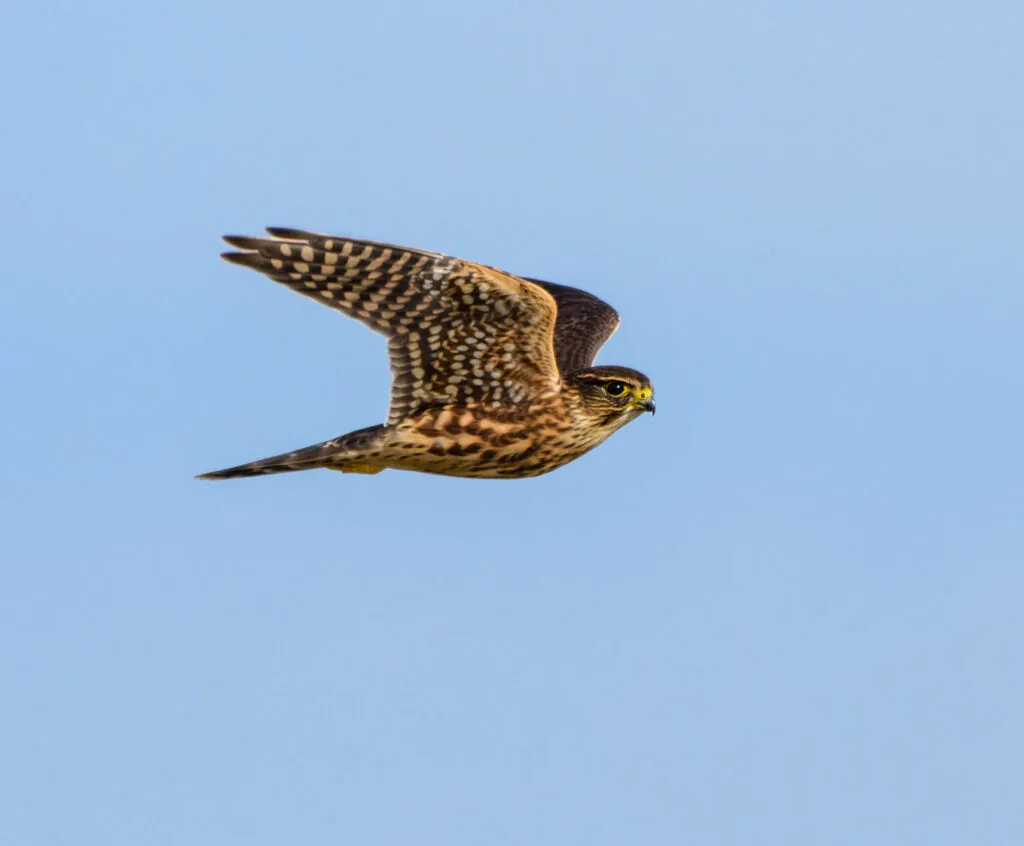
Merlin falcons can be described as small, fierce, and plentiful. This highly adaptable species is widespread in the northern hemisphere, and many migrate to warmer tropical areas during winter.
Once known as pigeon hawks, merlin are small falcons with big personalities. Their scientific name is Falco columbarius, and like other types of falcons, females are larger than males.
The average weight for females is 8.1 ounces, and in comparison, males are lightweight, 5.8 ounces.
Since the species is so widespread, there is regional variation in color, which has resulted in Merlin falcons being divided into nine distinct subspecies. They nest in cliffs and tree cavities.
Merlins use a low-flying hunting approach to pluck smaller birds out of the air or surprise them in shrubs and trees.
The main diet of merlin is birds, but they are known to attack almost any other animal they observe.
It is often possible to positively identify them as they may be spotted harassing much larger birds for their catches, including larger raptors like Golden Eagles. These small birds are incredibly feisty.
10. Bat Falcon (Falco rufigularis)

Bat falcons, Falco rufigularis, are attractive dark color birds of prey found throughout central and South American countries except for Chile and Uruguay.
Their name derives from the belief that bats are their main diet, although it has subsequently been found that they consume more small birds than bats.
These diminutive birds of prey have similar markings in both sexes. On average, females weigh between 6.2 and 8.5 ounces, and males are between 3.8 and 5.3 ounces.
There is some regional variation in appearance, and three subspecies of bat falcons have been described.
They are typically a dark bluish-black on the upper body with a lighter color throat and upper breast.
Bat falcons have a black and white barred long waistcoat section until midway down the underbelly, and the lower area is a rich rusty chestnut.
A bat falcon made headlines among birders in the United States in 2022 when a specimen was spotted in Alamo, Texas.
It was the first time that one of these types of falcons had been seen in the USA, and its appearance had birders traveling from as far afield as New York to view it.
11. Oriental Hobby (Falco severus)
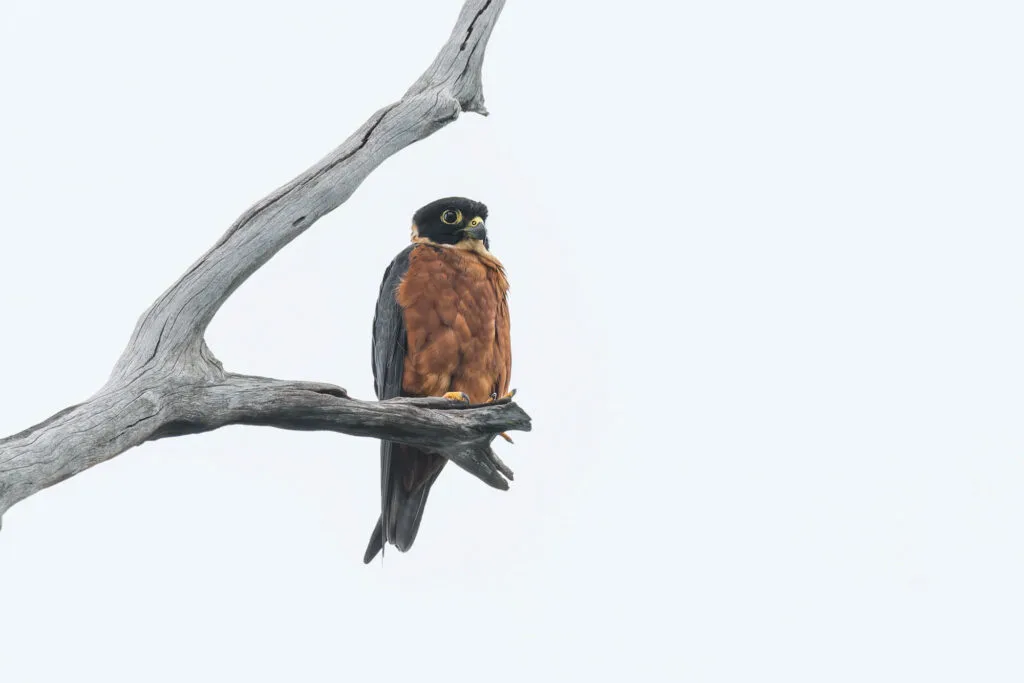
The oriental hobby goes by several names, including Burmese hobby and Indian hobby.
These additional names refer to places where these small falcons are common, which include the Indian subcontinent and southwards towards Indochina, through to New Guinea and the Philippines. Their scientific name is Falco severus.
These small falcons are found around forest edges, grasslands, plantations, and clearings. They are frequently spotted perched in trees, where they scan the vicinity for prey.
Oriental hobby’s are small birds of prey that feed on anything from small birds to insects.
They are well known for hunting dragonflies as they hover over open water. These falcons most often hunt at dawn or dusk.
The sexes are similar in appearance, and the average weight for these falcons is between 5.9 and 8.7 ounces.
Some Oriental hobbies, particularly those living in the Himalayan regions, migrate to warmer areas during winter.
12. Sooty Falcon (Falco concolor)

The sooty falcon, Falco concolor, gets its name from its gray plumage, which looks like it is covered in a thick coating of sooty ash.
These medium-sized birds of prey are long-distance migrants that breed in islands and coastal cliffs in north Africa and southwestern Asia but winter in the balmy climate of Madagascar and eastern coastal areas of South Africa.
Sooty falcons break from the norm in terms of falcon hunting behavior and have been observed hunting in cooperative groups of up to fifteen birds.
They feed mainly on birds but also take advantage of swarms of insects, lizards, and even crabs.
Male and female sooty falcons are almost identical and have an average weight of between 10.5 and 12 ounces.
An interesting feature of this species is that they are not fussy nesters, and if they can’t find suitable cliffs or rocks, they may use a spot between stones or on the ground.
13. Saker Falcon (Falco cherrug)
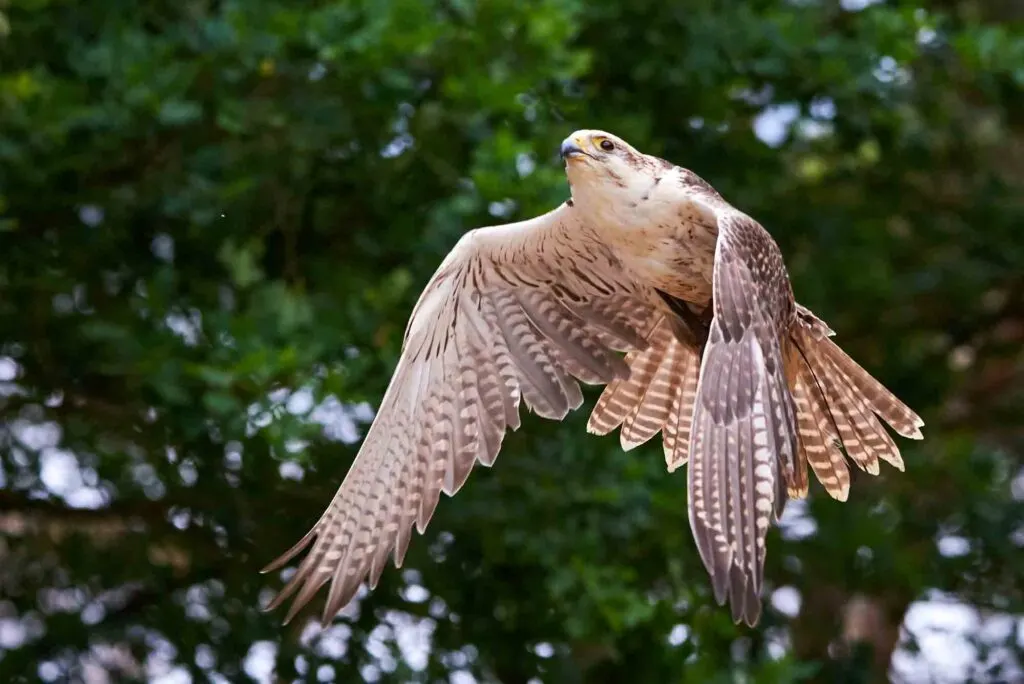
Saker falcons are interesting as they are one of the species that fit into the hierofalcon group.
That means this species is closely related to three other types of falcons: the laggar falcon, lanner falcon, and gyrfalcon. In appearance, these birds all resemble peregrine falcons.
These powerful birds of prey inhabit mountainsides, semi-deserts, and grasslands in several parts of Europe, northern Africa, and Asia.
Saker falcons, which have the scientific name Faldo cherrug, are unfortunately classified as endangered.
Their numbers are threatened not only by habitat loss and poisoning, but these birds are targets for trappers as they are highly prized in falconry.
Male and female saker falcons are similar in appearance. As with most types of falcons, females are considerably bigger and can weigh between 2.2 and 2.8 pounds.
By contrast, the average weight for male sake falcons is between 1.6 – 2.1 pounds.
Saker falcons are masters of hunting and can swoop down at impressive speeds to pick up small mammals, including hamsters and voles.
They also readily prey on birds and can catch smaller birds in flight, although they seem to prefer snatching prey off the ground. They have even been known to steal meals from other raptors.
14. Red-Footed Falcon (Falco vespertinus)
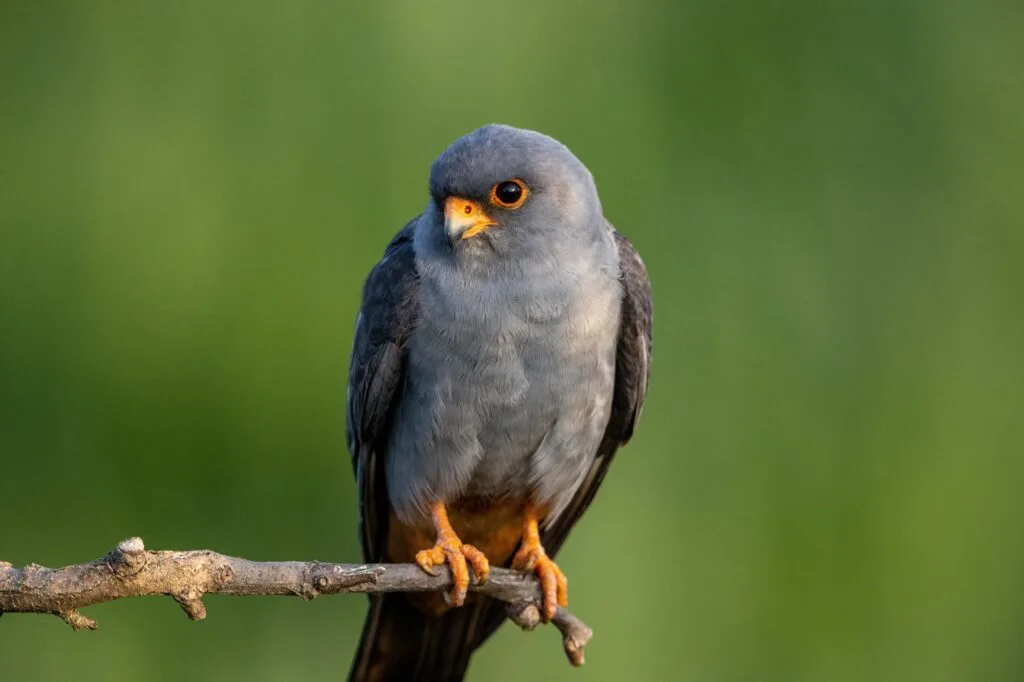
The red-footed falcon, Falco vespertinus, is found in parts of Eastern Europe and Asia. It is a migratory bird, and when winter gets closer, it heads south into Africa.
Vagrant red-footed falcons have been spotted as far afield as Western Europe. One lost specimen has even been seen in Martha’s Vineyard in the United States!
Male and female red-footed falcons differ considerably in appearance. Males are gray, while females of the species are light brown.
As their name suggests, red-footed falcons have red feet! They are small birds, and their average weight is between 4.5 and 7 ounces.
Since they are small falcons, their prey includes a wide variety of insects like locusts and moths.
However, like other falcons, they will also prey on small birds, mammals, reptiles, and amphibians.
Unfortunately, habitat loss has resulted in a sharp decrease in the numbers of these small falcons.
Since they depend on rook’s nests to breed, the destruction of these roosts, either from hunting or cutting down trees, has severely impacted red-footed falcon numbers. They are categorized as vulnerable by the IUCN.
15. Gray Kestrel (Falco ardosiaceus)
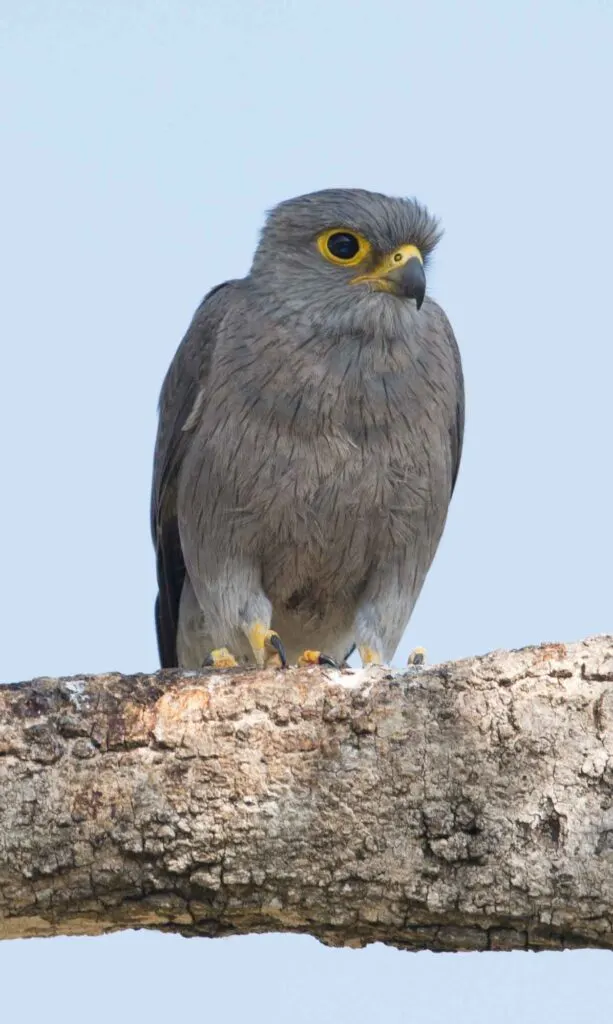
The Gray Kestrel’s scientific name is Falco ardosiaceus, and it is exactly what its name describes.
Although that may not sound exciting, with so many different types of falcons in the family, the gray kestrel is a bird of extraordinary beauty.
The dark gray feathers are offset by striking yellow eye rings, cere, and legs.
Gray kestrels are found in the western and central regions of Africa, where it inhabits open woodlands, forest clearings, and savanna regions.
Male and female gray kestrels are similar in appearance, except for a slight size difference, with females being slightly larger. The average weight for these birds is between 7.2 and 10.5 ounces.
The diet of gray kestrels is varied and includes anything they can find that is smaller than themselves. This includes birds, bats, mammals, reptiles, insects, and amphibians.
Like most types of falcons, gray falcons are usually solitary. However, they break this rule if there is a sudden abundance of food, for example, when insects from a termite heap are swarming.
16. Australian Hobby (Falco longipennis)
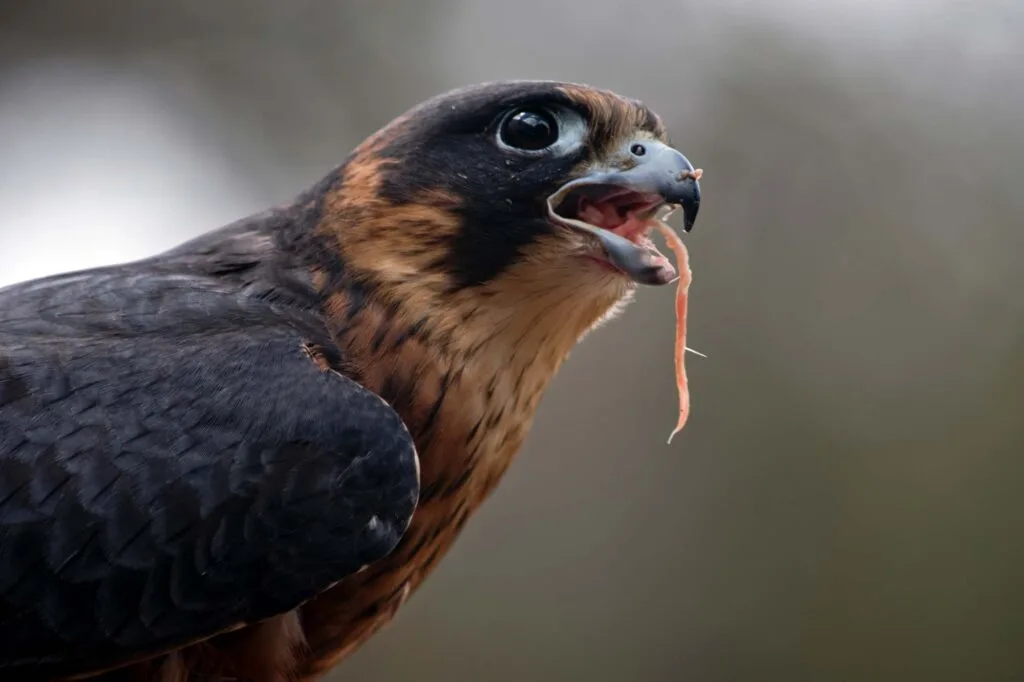
The land down under is certainly not left out when it comes to falcons, and it has several unique varieties.
The Australian hobby is a small falcon that occurs throughout Australia and the surrounding islands of New Guinea and Indonesia.
Australian hobbies – their scientific name is Falco longipennis – are also frequently referred to as little falcons.
They are adaptable birds that inhabit open woodlands, parks, gardens, and even urban settings. They seem to avoid areas near cliffs and escarpments.
Although the Australian hobby is often mistaken for peregrine falcons, they are considerably smaller.
It is also much thinner and not quite as slick in the air as the peregrine falcon. Adult hobbies weigh between 7.6 and 9.5 oz.
These tiny Aussies are the smallest raptors in Australia. They usually hunt early in the morning and at dusk, and their diet consists mainly of smaller birds, large insects, bats, and mammals.
17. Black Falcon (Falco subniger)
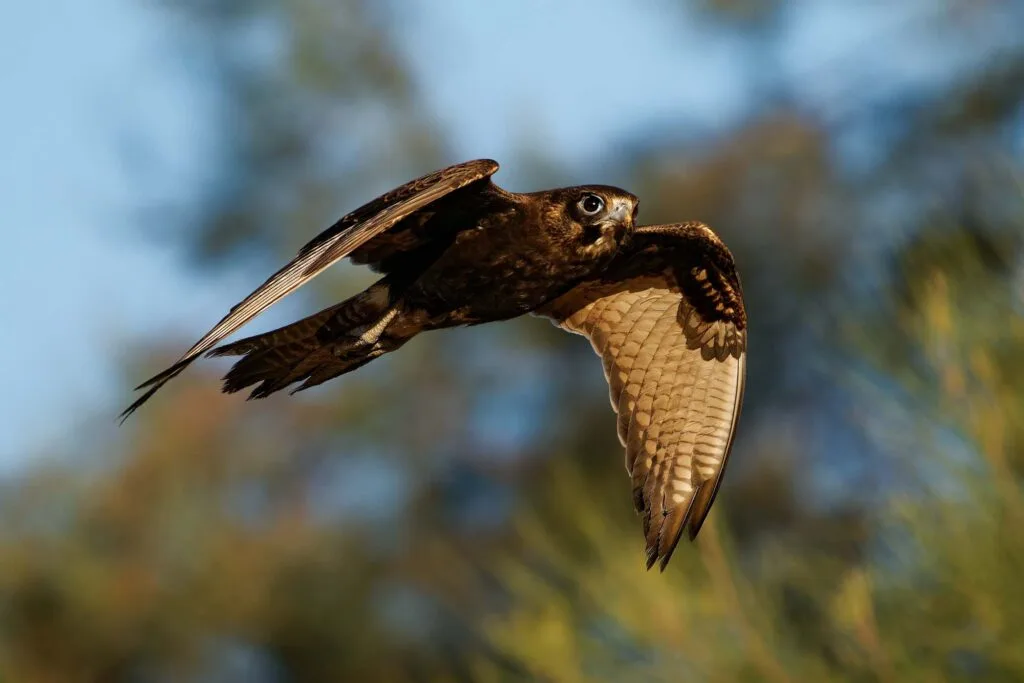
Australia boasts another magnificent species of falcon. As its name describes, the black falcon has dark feathers, although it can be challenging to tell apart from its countrymate, the brown falcon.
Distinctive features of black falcons are their feathered legs, pointed wings, and broad shoulders.
Black falcons are found in all states and territories in Australia and are especially common falcons in central and eastern regions.
They are only rarely sighted in Western Australia, and they also avoid densely forested areas in other areas within their range.
Males and females have similar dark sooty color plumage, although females are larger and weigh around 29.3oz while the average weight of males is 20.5oz.
Black falcons take over tree nests of corvids to breed and may also occasionally occupy nests of other birds.
The diet of black falcons consists mainly of other birds. They prey on birds that range in size from tiny Zebra finches to gray teal ducks, which are cute duck types from Australia.
In addition, black falcons will readily take rabbits, mice, insects, and even carrion.
18. Nankeen Kestrel (Falco cenchroides)
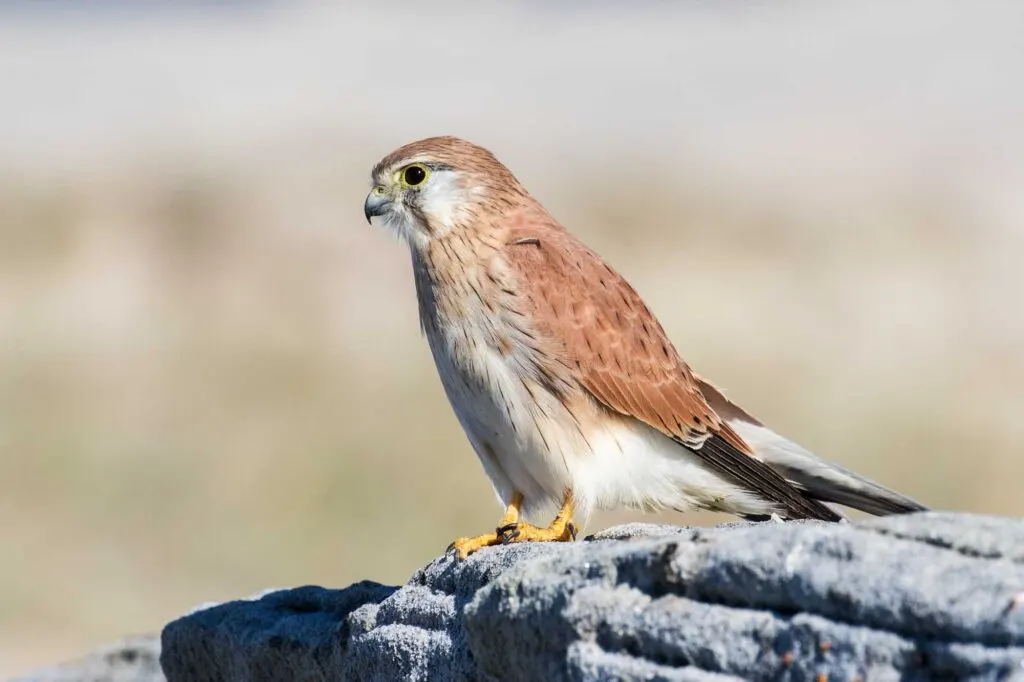
The Nankeen kestrel is one of the most commonly observed birds in Australia.
They are abundant and widespread on the continent as well as in neighboring New Guinea and Indonesia. Their scientific name is Falco cenchroides.
Scientists attribute nankeen kestrels’ healthy population to its varied diet and ability to adapt to a wide range of habitats.
These small raptors will readily consume prey ranging from insects to reptiles, mammals, and other birds.
Like other types of falcons, nankeen kestrel females are slightly larger than males. The average weight of females is between 4.1-9.6oz, and males tip the scales between 4.3-6.9oz.
Both sexes have a rufous-brown upper body, and their underbodies are white with fine streaking. Males tend to have more gray in their tails, but this varies between individuals.
Nankeen kestrels use a variety of hunting methods. They often hover over fields while beating their wings to stay in one place to survey the ground, or they will find a suitable perch from which they can launch a sudden aerial attack.
In addition, they are able to catch insects or other birds in midair.
19. Eleonora’s Falcon (Falco eleonorae)
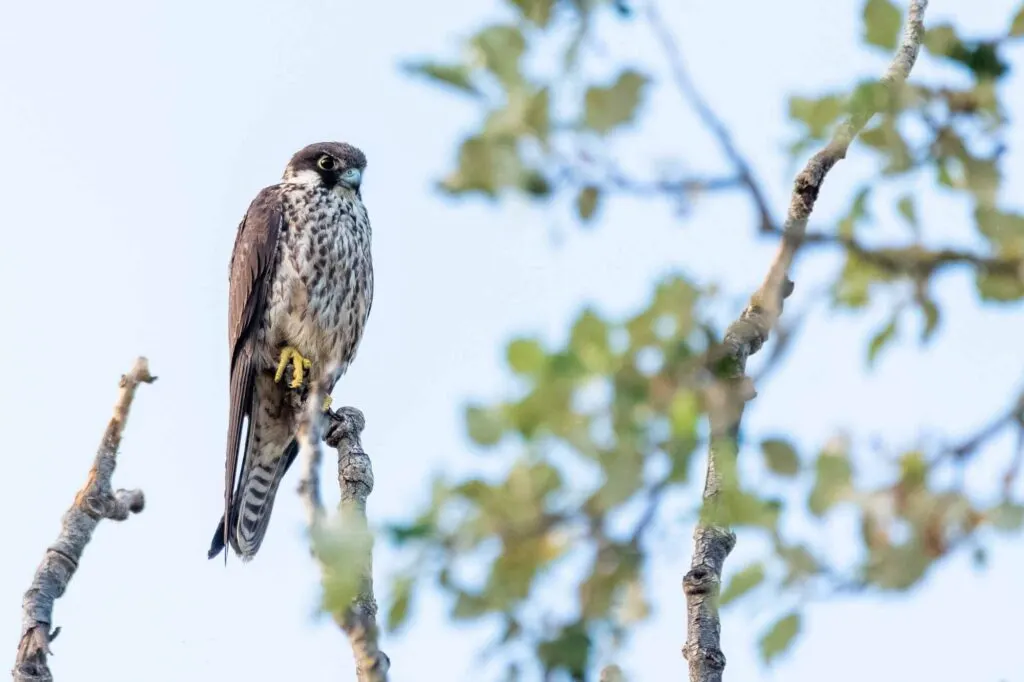
Eleonora’s falcon is the last falcon on our list of different types of falcons.
These slender falcons spend their summers in warm Mediterranean islands near Greece and in Cyprus, Spain, Italy, and Morocco, where they nest on coastal cliffs.
In winter, they migrate south to Madagascar.
Eleonor’s falcon (Falco elenorae) was named after Eleanor of Arborea, the first ruler in history who, in 1392, granted protection to falcon and hawk nests against hunters.
The falcons have long wings and tail feathers and are elegant birds that come in two distinct color morphs.
The average weight of these medium-sized falcons is 12 – 16.22 ounces. Males and females are similar in appearance.
They may both appear in either the dark sooty brown color morph or the much lighter variation.
A unique and somewhat gruesome characteristic of Elenora’s falcon is that they are efficient hunters of small birds and have a technique of ‘storing’ their prey alive for several days.
Captive birds may have their flight feathers removed and be imprisoned in rock crevices for several days at a time before being consumed.
Eleonora’s falcons also feed on insects like dragonflies which are caught midair and eaten in flight. They have also been observed catching bats.
Did you enjoy learning more about different types of falcons? Then share this article with your friends on social media!
19 Different Types of Falcons
1. Peregrine Falcon
2. Gyrfalcon
3. Pygmy Falcon
4. American Kestrel
5. Prairie Falcon
6. Orange-Breasted Falcon
7. Common Kestrel
8. Aplomado Falcon
9. Merlin
10. Bat Falcon
11. Oriental Hobby
12. Sooty Falcon
13. Saker Falcon
14. Red-Footed Falcon
15. Gray Kestrel
16. Australian Hobby
17. Black Falcon
18. Nankeen Kestrel
19. Eleonora’s Falcon
